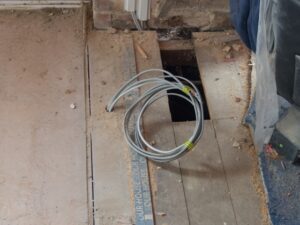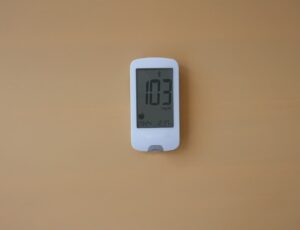Dealing with a clogged kitchen sink can be incredibly frustrating, but the good news is that it’s a problem you can solve!
Using a reliable kitchen sink drain cleaner is a great way to restore your sink to full working order. Whether it’s food residue, grease buildup, or just everyday use, having the right cleaning solution at your disposal is key to avoiding these kitchen headaches.
Now, how do you choose the right drain cleaner?
With so many options available, it’s important to pick the one that will best address your specific problem. Enter Excel Mechanical – we’re here to help!
Whether you’re dealing with a small clog or need a professional touch, our team provides expert plumbing services tailored to both residential and commercial spaces. We ensure that your plumbing system remains in top condition, efficiently tackling issues like clogged drains and so much more.
In this blog, you will learn:
- The different types of kitchen sink drain cleaners and how to choose the right one.
- Simple yet effective tips for regular drain maintenance to prevent future clogs.
- The best practices for handling stubborn kitchen sink clogs and when to call in the professionals.
Let’s dive into some expert tips to help you handle kitchen sink drain problems with ease.
Understanding Kitchen Sink Drain Systems
Kitchen sink drain systems are essential for a smooth-running kitchen.
They consist of several parts that work together to ensure proper drainage. Knowing these components can help you maintain your sink more effectively.
Main Components:
- Drain Trap: This U-shaped pipe prevents sewer gases from entering your home.
- Strainer Basket: Located at the sink’s bottom, it filters out larger debris.
- Waste Pipe: Connects the drain trap to the household plumbing.
Keeping your sink in good condition involves regular cleaning. Tools like a plunger or a plumber’s snake can be useful for removing clogs.
Avoid pouring fats, oils, or grease down the drain to prevent blockages. Instead, dispose of them in the trash. Baking soda and vinegar can be used occasionally for maintenance by breaking down minor buildups.
Types of Kitchen Sink Drain Cleaners
Kitchen sink drain cleaners vary in their approach to tackling clogs and buildup.
There are three main types: chemical cleaners, enzymatic cleaners, and mechanical tools. Each has its unique benefits and ideal use cases.
Let’s explore each of them!
Chemical Cleaners
Chemical cleaners use powerful substances to clear clogs and buildup in drains. These products often contain ingredients like sodium hydroxide or sulfuric acid. They work by breaking down organic materials and dissolving grease quickly.
This type of cleaner is especially effective for tough clogs caused by food waste and grease. However, you need to handle them carefully, following all safety instructions to avoid harm to your pipes or yourself. Ventilate your area well, and wear gloves and goggles while using chemical cleaners.
These cleaners are best suited for urgent situations where speed is essential.
Dense, stubborn clogs that don’t respond to other methods are prime candidates for chemical treatments. Due to their potential strength, these substances can also wear pipes over time, so use them sparingly to maintain the longevity of your plumbing system.
Enzymatic Cleaners
Enzymatic cleaners are a gentler alternative, using natural enzymes and bacteria to break down substances clogging your drain. These cleaners are biodegradable and typically safer for your pipes and the environment. They work best on organic matter such as hair, soap scum, and food particles.
These products often need more time to work than chemical cleaners. They are preferable for regular maintenance in preventing clogs from forming. Though they might not clear a severe blockage quickly, they help keep your drains flowing smoothly with regular use.
Since enzymatic cleaners are safer, they are ideal for eco-conscious households. They are less likely to damage pipes or septic systems. We recommend regular enzymatic cleaning for ongoing maintenance to extend the life of your plumbing system.
Mechanical Tools
Mechanical tools provide a physical solution to drain clogs.
Tools like plungers, drain snakes, and augers can manually dislodge blockages. They are effective on a variety of clogs, particularly those caused by food particles or small objects.
Using these tools often requires a bit of elbow grease but offers an immediate and chemical-free approach. They are reusable and cost-effective, making them a practical addition to any household toolkit.
Safety Precautions
When using kitchen sink drain cleaners, safety is your top priority.
- These products can contain strong chemicals that may cause harm if improperly handled. Always wear protective gear, such as gloves and goggles. This will help protect your skin and eyes from potential burns or irritation.
- Work in a well-ventilated area. This reduces the risk of inhaling harmful fumes released by the drain cleaner. Keep windows open or use exhaust fans to ensure good airflow.
- Accidental spills can happen. If the drain cleaner contacts your skin, rinse immediately with plenty of water. If it gets into your eyes, flush them thoroughly and seek medical assistance if needed.
- Read and carefully follow all instructions on the product label. This ensures the safe and effective use of the cleaner in your kitchen sink. Store these chemicals out of reach of children and pets to prevent accidental exposure.
- Turn to trusted professionals like Excel Mechanical for expert advice on plumbing and HVAC services. We are strongly dedicated to quality and value and provide tailored solutions to fit your specific needs and budget both for residential and commercial settings.
Take these precautions seriously to ensure a safe cleaning process. By staying informed and prepared, you can confidently handle drain issues in your kitchen.
Preventive Maintenance Tips
Regular maintenance can keep your kitchen sink drain clean and free of clogs. Here are some most effective tips for preventive maintenance:
- One simple way is to pour a large pot of hot (not boiling) water down the drain once a week. This helps to dissolve buildup that can lead to blockages.
- Try using a mixture of baking soda and vinegar. Pour 1/2 cup of baking soda into the drain, followed by 1/2 cup of vinegar. Let it sit for a few minutes before flushing with hot water. This combination helps clear debris and kill bacteria.
- Avoid pouring grease or oil down the drain. These substances can harden and cause clogs. Instead, dispose of them in the trash or recycle them safely. Consider using a strainer to catch food particles before they drain. Cleaning the strainer regularly can prevent future blockages.
- Use products like enzyme or bacterial drain cleaners once a month. These are non-corrosive and safe for your pipes, breaking down organic matter effectively.
Common Drain Blockages and Their Causes
Drain blockages in your kitchen can be a real hassle. Understanding what causes them can help in preventing future problems.
- Food scraps are a big culprit. When you wash dishes, small pieces of food can slip into the drain, leading to clogs over time.
- Grease, oils, and fats are also known to cause serious blockages. As they cool and solidify, they stick to the walls of your pipes. It’s a common misconception that hot water prevents this, but it doesn’t. Avoid pouring them down the sink to keep your drain clear.
- Another issue is pasta, rice, and potatoes. These foods expand in water, forming a thick paste-like substance in your pipes. To avoid problems, dispose of them in the trash instead of the sink.
- Coffee grounds should also be noted. While they seem harmless, they can settle and cause pipe blockages over time. To prevent this, always discard coffee grounds in the trash.
- Hair and fur are common causes, especially if your kitchen is near areas where pets are groomed. Hair and fur can tangle and build up quickly inside drains.
Step-by-Step Cleaning Guide
Keeping your kitchen sink drain clean can prevent clogs and unpleasant odors. By following these steps, you can easily maintain a clear and efficient drain.
Preparing the Area
Before you start cleaning, gather your supplies.
You will need a pot for boiling water, a natural cleaner such as baking soda or vinegar, and a scrubbing brush. Clear the sink area of dishes and any debris to avoid interference while working.
Boiling water is effective at loosening buildup. If your sink has a disposal unit, switch it off to prevent accidents. Safety is key, so use caution when handling hot water.
Proper preparation helps streamline the cleaning process and ensures effective results.
Applying the Cleaner
Start by pouring half a cup of baking soda into the drain. Follow this with a cup of vinegar to create a fizzing reaction that helps to break down residue and eliminate odors.
Let the mixture sit for 10-15 minutes to allow it to work on tough debris. Baking soda is effective because it’s a gentle abrasive that doesn’t damage surfaces.
You may need to repeat the process for tougher clogs. Utilizing these natural cleaners avoids harsh chemicals and keeps your kitchen eco-friendly.
Rinsing and Testing Drain Flow
Boil a pot of water and carefully pour it down the drain. This step flushes out any remaining cleaner and debris. You may need to repeat this to ensure the drain is clear.
Test the flow of water by running the tap. A smooth drain flow indicates the cleaning was successful. If the flow is still restricted, consider contacting professionals like Excel Mechanical. Our team is known for exceptional quality in both residential and commercial plumbing.
When to Hire a Professional
Recognizing when to call a professional for your kitchen sink drain is important. Sometimes you can handle minor clogs yourself, but there are certain situations where expert help is essential.
Signs You Need a Professional:
- Persistent Clogs: If your sink drains slowly even after using a cleaner, it might be time to call in the experts.
- Foul Odors: Bad smells coming from the drain could indicate deeper issues.
- Multiple Clogs: If more than one drain is clogged in your home, you may have a bigger problem with your plumbing system.
Hiring a professional ensures that the issue is addressed efficiently and safely. DIY methods might be quick fixes, but they can sometimes lead to more damage. A professional has the right tools and expertise to detect and solve problems.
Why Choose Excel Mechanical?
Excel Mechanical offers exceptional HVAC and plumbing services tailored to your needs and budget.
Whether it’s residential or commercial, our professionals deliver high-quality solutions. We strive for exceptional quality and great value in every service we provide, making us a reliable choice for your drain cleaning needs.
Taking action at the right time can save you from costly repairs and ensure that your plumbing system remains in good condition.
Long-term Drain Health
Maintaining your kitchen sink’s drain health is key to a smoothly running home. Simple regular habits can prevent clogs and keep pipes in good condition.
Here is all you need to know:
- For instance, avoid pouring grease or oil down the drain, as these substances can solidify and cause blockages over time.
- Use a drain strainer to catch large food particles. This simple device prevents debris from entering your pipes and causing clogs. Regularly cleaning the strainer also enhances its effectiveness.
- A monthly cleaning routine is beneficial. Pouring a mixture of baking soda and vinegar down the drain can help remove buildup. This eco-friendly method is gentle on pipes and effective in breaking down grime.
- Regular inspections by professionals can uncover potential issues before they become major problems. Our team is equipped to handle residential and commercial plumbing needs, ensuring the longevity and efficiency of your systems.
- Ensure you monitor your drains for any signs of trouble. Slow drainage or foul odors could indicate underlying issues that require attention. Addressing these early can save money and prevent further damage.
Eco-Friendly Alternatives
When considering eco-friendly options for cleaning your kitchen sink drain, there are several effective solutions.
- Natural Enzymes and Bacteria: These cleaners use natural enzymes and bacteria to break down clogs. They are gentle on pipes and safe for the environment, and unlike harsh chemicals, they won’t harm your plumbing.
- Baking Soda and Vinegar: A classic combination that’s easy to use. Pour 1/2 cup of baking sod, followed by 1/2 cup of vinegar, down the drain. Let it sit for about an hour, then flush with boiling water. This mix can help with minor clogs.
- Hot Water and Dish Detergent: Use dish detergent with hot water for grease clogs. This method is effective against oily buildups, especially in kitchen sinks. Mix a generous squirt of detergent with boiling water and pour it down the drain to help clear the blockage.
Homemade Cleaners:
- Lemon and Baking Soda: Combines natural citrus power with baking soda for a fresh-smelling, effective cleaner.
- Salt and Hot Water: Use this pair to tackle minor blockages by dissolving buildup.
Excel Mechanical is the go-to service provider when you need reliable plumbing solutions. We help you choose the best system for residential and commercial needs, ensuring satisfaction and efficiency.
Frequently Asked Questions
Kitchen sink drains can be tricky, but with the right knowledge and tools, you can handle almost any situation. Here are some common questions and solutions to help you effectively navigate kitchen sink drain cleaning.
What is the most effective drain cleaner for kitchen sinks with heavy grease buildup?
Mixing hot water, baking soda, and vinegar can help emulsify the grease buildup. This combination creates a reaction that can break down the grease, making it easier to rinse away. You can find more about this method on sites like Bob Vila.
How do I unclog a kitchen sink with a garbage disposal unit?
To address clogs in a sink with garbage disposal, ensure the unit is turned off first. Then, use a flashlight to check for visible blockages. If none are present, run cold water and try a mixture of baking soda and vinegar. If that doesn’t work, use the reset button on the disposal unit.
What are the top recommended tools for clearing a kitchen sink drain?
A plunger and a plumber’s snake are essential for clearing stubborn clogs in kitchen sinks. A plunger can help loosen blockages, while a plumber’s snake can reach deeper clogs. These tools are effective for dislodging particles stuck further along the pipe.
What solutions work best for kitchen sinks prone to hair clogs?
For hair clogs, consider using a drain hair catcher to prevent hair from going down the drain. If hair gets clogged, try mixing baking soda and vinegar followed by boiling water. This helps to dissolve and wash the hair away, keeping the drain clear.
How do professionals suggest dealing with persistent odors in kitchen sink drains?
Professionals recommend regular cleaning with baking soda and vinegar to combat odors. Pour baking soda down the drain, followed by vinegar, allowing it to sit before rinsing with hot water. For persistent smells, professional services like Excel Mechanical offer tailored solutions to effectively eliminate drain odors.
What steps should be taken to unclog a kitchen sink drain naturally?
To unclog a kitchen sink naturally, start by pouring boiling water down the drain. Next, follow this with a mixture of baking soda and vinegar. Let it sit for 15 minutes before flushing with more boiling water. This process helps to break up clogs without harsh chemicals.




